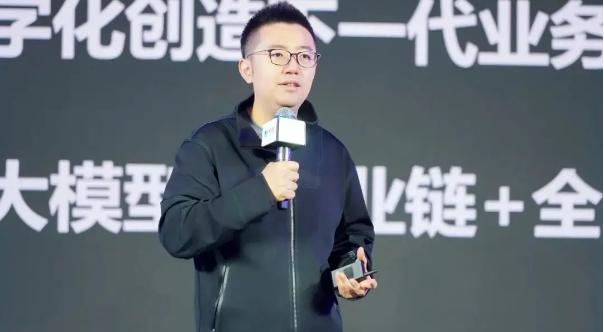
Positive Comments: The “Artificial Intelligence +” Strategy Ushered in a New Era of Industrial Intelligent Reconstruction, Unleashing the Dual Dividends of Scenarios and Technologies
In 2025, the national “Artificial Intelligence +” strategic framework was launched, marking that China’s artificial intelligence development has officially shifted from the “technological breakthrough” stage to the crucial “scenario implementation” stage. The timeliness and foresight of this top – level design not only match the characteristics of the “second half” of the global AI technology evolution – intelligence is no longer scarce, and the ability to architect intelligence becomes the core. Moreover, it promotes the “two – way pursuit” between the industry and technology through policy guidance, injecting new impetus into the intelligent transformation of all industries.
First of all, the launch of the strategy precisely responds to the dual needs of the industry and technology. From the industrial end, traditional industries are facing growth bottlenecks and urgently need new productive forces to break through. From the technological end, the iteration of AI requires the value feedback of industrial scenarios; otherwise, it will become a “source – less stream”. China’s vast industrial foundation (such as manufacturing, services, medical care, and education) provides a globally rare “scenario treasure trove” for AI, and the “Artificial Intelligence +” strategy is the key driving force to transform this comparative advantage into the impetus for technological implementation. For example, the “one – million – employee problem” mentioned by Professor Sun Tianshu – if the value of a scenario can be significantly improved by the addition of one million intelligent agents, then this scenario is naturally suitable for AI reconstruction. This judgment standard provides a clear scenario screening logic for enterprises, avoiding blind investment.
Secondly, “Artificial Intelligence +” redefines the underlying logic of enterprise value creation. Different from the “Internet +” which only changes channels and connections, AI, as the “intelligent core”, will directly participate in the closed – loop of decision – making, execution, and feedback, promoting the “native reconstruction” of business models, organizational structures, and even business models. For example, in the education scenario, AI intelligent agents can dynamically adjust teaching content based on students’ personalized needs, upgrading the traditional “one – to – many” model to “one – to – one” intelligent service, and the knowledge value of teachers is exponentially magnified. In the medical scenario, AI – assisted diagnosis systems can improve the diagnosis accuracy of primary – care doctors by analyzing a large amount of case data. The implementation of this “intelligent native” thinking essentially upgrades AI from a “tool” to a “business partner”, and its value far exceeds the previous discrete technological applications.
Moreover, the strategy has opened up new opportunity windows for entrepreneurs and small and medium – sized enterprises. Sun Tianshu pointed out that large enterprises will monopolize the super C – end entrances in the short term, but the reconstruction of B – end industrial scenarios is still at the “same starting line”. AI – native startups, with the advantages of light assets and no historical burdens, can transform the “core assets” (such as heavy – asset equipment and fixed processes) of traditional enterprises into “core liabilities” and achieve leap – frog growth through the leverage of intelligent agents (scale by agents). For example, in the field of manufacturing quality inspection, traditional enterprises rely on manual visual inspection or fixed algorithms, while AI – native enterprises can optimize the inspection model in real – time through dynamically learning intelligent agents, covering more complex scenarios at a lower cost and quickly seizing the market.
Finally, “Artificial Intelligence +” promotes the upgrading of the talent structure to a “composite” one. The strategy clearly lists “AI architects” as the core scarce resources – these talents understand both industrial scenarios and the capabilities of intelligent agents and can architect the next – generation business forms. Although there is currently a mismatch between “industries having scenarios but lacking architectural capabilities and technical talents lacking industrial experience”, under the policy guidance, the “overflow” of Internet talents into traditional industries (such as moving from the “small mountain” of the Internet to the “big mountain” of industries) is expected to accelerate the “battlefield tempering” of AI architects and reserve key talents for industrial transformation.
Negative Comments: Cognitive Gap, Talent Mismatch, and Implementation Risks – “Artificial Intelligence +” Still Needs to Overcome Multiple Challenges
Although the “Artificial Intelligence +” strategy has broad prospects, it still faces multiple practical challenges during the implementation process. If not handled properly, it may lead to the embarrassing situation of “hot policies but cold implementation”.
First and foremost, the deep – seated restriction of the “AI cognitive gap” looms large. Sun Tianshu pointed out that the current development speed of AI technology far exceeds the absorption capacity of the industry. The core contradiction lies in the lack of “AI architectural thinking” among entrepreneurs and decision – makers. Many enterprises still view AI as a “tool” (such as purchasing a few intelligent customer service or analysis software) rather than reconstructing business scenarios from the “intelligent core”. For example, a manufacturing enterprise invested in AI for production line monitoring, only regarding it as a tool to replace manual inspection, but failed to use the dynamic learning ability of intelligent agents to optimize the production process. As a result, the value of AI only stayed at “cost reduction” rather than “efficiency improvement + innovation”. This cognitive bias may cause enterprises to fall into the trap of “using AI for the sake of AI”, wasting resources while failing to achieve business growth.
Secondly, “talent mismatch” has become the core bottleneck for implementation. The cultivation of AI architects requires a practical environment of “scenarios + data + feedback”, rather than simply technical or theoretical learning. However, there is a “systematic mismatch” between industrial enterprises and technical talents: traditional enterprises have scenarios and data but lack the incentive mechanisms (such as salary and innovation space) to attract top – notch AI talents; technical talents understand AI architecture but have difficulty in deeply understanding industrial pain points (such as the diagnosis process in medical care and the technological details in manufacturing). This mismatch may lead to the situation of “those who understand technology not understanding scenarios and those who understand scenarios not understanding technology”, and the implementation of AI becomes a “technological show – off” rather than “value creation”. For example, an auxiliary diagnosis system developed by a medical AI company was shelved in the end because it did not understand the actual operating habits of primary – care doctors, with a complex interface and long response time.
Moreover, the contradiction between “short – term investment and long – term value” may dampen enterprises’ enthusiasm. AI – based scenario reconstruction requires upfront investment in data cleaning, process transformation, and intelligent agent training, and the value realization is lagged (for example, it takes 3 – 5 years to verify the effectiveness of an intelligent teaching system in the education scenario). Many enterprises hesitate due to their inability to measure the short – term ROI (return on investment). Although the design of the “intermediate indicators” mentioned by Sun Tianshu (such as disassembling GMV into sub – indicators such as member repurchase rate and customer unit price that can be fed back) is a solution, in actual operation, enterprises may fail to accurately define these indicators due to the lack of “AI architectural thinking”, resulting in the investment direction deviating from the core value.
In addition, the difference in the measurement standards between “policy goals and actual value” may lead to formalism. The strategy sets the goal of “application penetration rate exceeding 70%” by 2027, but Sun Tianshu emphasizes that the value of AI should be measured by “scenario reconstruction” rather than “application quantity”. If local governments or enterprises simply understand the “penetration rate” as “the number of installed AI systems”, it may lead to a large number of low – value scenarios being “pseudo – intelligentized” (such as using AI to generate irrelevant reports and replace simple repetitive labor) rather than truly driving business model transformation. This tendency of “implementing for the sake of meeting the standard” may weaken the actual driving effect of AI on the economy.
Finally, the “core asset trap” of traditional enterprises may hinder transformation. The advantages of many leading enterprises (such as a large number of offline channels and fixed organizational processes) may become “core liabilities” in the AI era. For example, a retail giant has thousands of stores across the country, but AI – native enterprises can meet users’ needs at a lower cost through intelligent supply chains and online – offline integration. If traditional enterprises stick to their existing assets, they may be surpassed by emerging enterprises due to slow transformation. However, breaking the “path dependence” requires the courage and determination of entrepreneurs, which is still a huge challenge for some conservative enterprises.
Advice for Entrepreneurs: Seize the Opportunity of Scenario Reconstruction and Build Core Competitiveness with “AI – Native Thinking”
Facing the wave of “Artificial Intelligence +”, entrepreneurs need to grasp the core logic of “intelligent scenario reconstruction” and build advantages from three aspects: scenario selection, thinking upgrade, and talent deployment.
Precisely Select “Native Scenarios” to Avoid Blind Investment
Entrepreneurs should give priority to scenarios with the characteristics of “three – many, one – high, and one – complex” (many employees, many customers, high costs, high – frequency interaction, and complex knowledge judgment), such as medical diagnosis, personalized education services, and manufacturing quality inspection. The potential of scenarios can be verified through the “one – million – employee problem”: assuming that one million intelligent agents are added, can the user value be significantly improved? If the answer is yes, then concentrate resources on in – depth development of this scenario to avoid “scattered” investment. For example, for the financial and tax service scenario of small and medium – sized enterprises (many customers, high – frequency interaction, and complex policy judgment), an intelligent financial and tax advisor can be developed. By dynamically learning policy changes and enterprise needs, it can provide personalized compliance advice, replacing traditional bookkeeping services.Cultivate “AI – Native Thinking” and Shift from “Achieving AI” to “Letting AI Achieve You”
Entrepreneurs need to break out of the “tool thinking” and regard AI as a “business partner” rather than an auxiliary tool. Specifically, they need to achieve three points: first, provide knowledge, data, tools, and permissions for AI intelligent agents (such as opening the enterprise’s internal knowledge base and connecting to external data sources); second, design human – machine collaboration processes (such as assigning human experts as “mentors” to intelligent agents to solve their shortcomings in intention recognition); third, establish a feedback and iteration mechanism (such as using user satisfaction and problem – solving rate as the “reward function” of intelligent agents to drive their continuous optimization). For example, in the legal technology field, entrepreneurs can first input a large number of cases and regulations into AI intelligent agents, and then gradually improve their judgment accuracy through the collaborative service of lawyers and intelligent agents (intelligent agents generate preliminary legal opinions, and lawyers review and optimize them), ultimately achieving an efficient model of “AI – led + human review”.Focus on “AI Architectural Ability” and Build Talent and Organizational Advantages
Entrepreneurs need to recognize that AI architects are the core assets of the team. They can attract cross – border talents through “scenario opening + market – based incentives”: on the one hand, open the enterprise’s real scenarios (such as customer needs and business processes) to let technical talents understand industrial pain points in practice; on the other hand, use flexible incentive methods such as equity and project sharing to attract “technology + business” composite talents from Internet or AI giants. In addition, entrepreneurs themselves need to improve their “AI architectural thinking” – even if they are not proficient in technical details, they need to have an intuitive judgment on the ability boundaries and evolution trends of AI (such as understanding the “Moore’s Law” that the task length of intelligent agents doubles every seven months), so as to lead the direction of scenario reconstruction at the strategic level.Balance Short – Term Investment and Long – Term Value and Use “Intermediate Indicators” to Guide Iteration
Entrepreneurs need to avoid giving up investment due to the lack of short – term returns. They can quantify the phased value by defining “intermediate indicators” (such as user retention rate and single – customer service cost reduction rate). For example, in the education SaaS field, “increase in students’ weekly learning time” and “reduction in teachers’ lesson – preparation time” can be used as intermediate indicators. These indicators can not only reflect business value but also serve as the “reward function” of intelligent agents (such as optimizing recommended content when the learning time increases), forming a positive cycle of “investment – feedback – optimization”.
In short, the essence of “Artificial Intelligence +” is “intelligent scenario reconstruction”. Entrepreneurs need to take “AI – native thinking” as the core, seize the opportunity of B – end industrial scenario reconstruction, and define the next – generation business model in the second half of the AI era through precise scenario selection, intelligent agent empowerment, and talent deployment, becoming the new leaders in the “intelligent era”.
- Startup Commentary”Building LLMs: The Knowledge Graph Foundation Every AI Project Needs”
- Startup Commentary”The 17th Year of Tmall Double 11 and the New Map Rewritten by AI”
- Startup Commentary”How to Prepare Your Data for Artificial Intelligence”
- Startup Commentary”Small and Medium-sized Banks: “Cutting the Tail” in Loan Assistance”
- Startup Commentary”The Six AI Giants on Stage: AGI Is No Longer a “Future” Thing”



